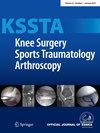The early peak knee abduction moment waveform is a novel risk factor predicting anterior cruciate ligament injury in young athletes: A prospective study
Abstract
Purpose
In this study, prospective data were used to evaluate whether the early peak knee abduction moment waveform is associated with the risk of anterior cruciate ligament (ACL) injury.
Methods
Biomechanical data from 84 athletes who participated in the study as adolescents were analysed after cross-referencing national health registry data to confirm ACL reconstruction in the subsequent years. The knee abduction moment waveform shape was obtained with cluster analysis for the first 100 ms of a cutting manoeuvre (1776 trials in total) and classified as either containing an early peak knee abduction moment or not, and the odds ratio for later ACL injury was then calculated. Additionally, discrete kinematic and kinetic variables were extracted, and tested against the risk of ACL injury using mixed model logistic regression.
Results
Of 84 athletes, 8 (all female) sustained a total of 13 ACL injuries in the years after motion analysis data collection. Six clusters of knee abduction moment waveform shapes were identified. Two clusters containing 446 trials were classified as an early peak knee abduction waveform. This waveform was associated with a 7.2-fold increase in the risk of ACL injury (95% confidence interval: 2.4–24.6; p < 0.001). Of the kinematic and kinetic variables tested, only the knee abduction angle at initial contact was associated with an increased risk of ACL injury (p < 0.001).
Conclusion
This is the first study to confirm the association between the early peak knee abduction moment waveform and the risk of ACL injury. Using waveforms, instead of discrete peak values of the knee abduction moment, may better represent risky movement patterns. Replicating these findings in a larger cohort will support the use of this method to screen athletes for risk and guide targeted preventive interventions and their efficacy.
Level of Evidence
Level II.


 求助内容:
求助内容: 应助结果提醒方式:
应助结果提醒方式:


